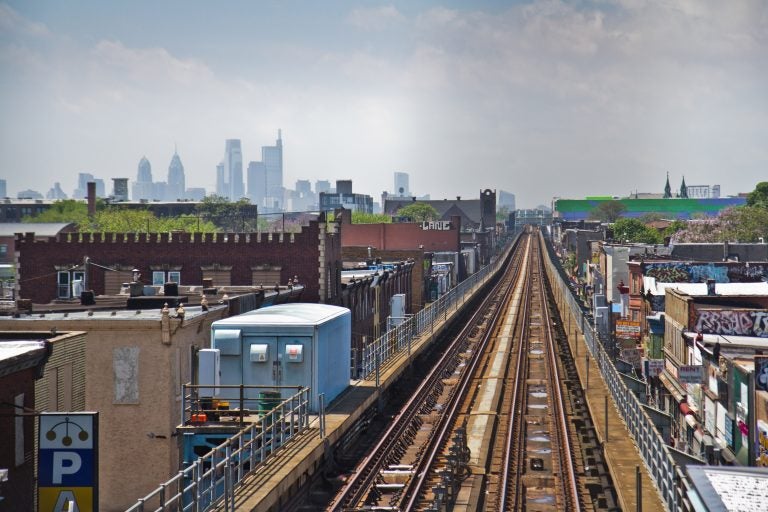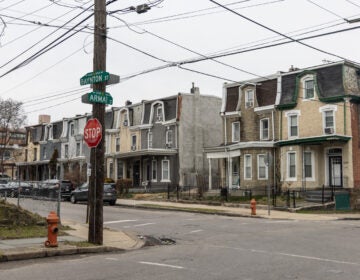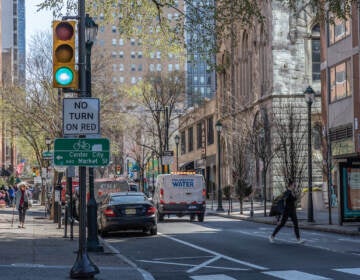Pew State of the City: Philadelphia’s workforce is more educated than ever, but poverty divide lingers
Philadelphia adults are more likely to have a college degree than the national average but less likely than some peer cities.
Listen 0:50
File photo: Looking out at the Philadelphia skyline from the Allegheny SEPTA station in Kensington. (Kimberly Paynter/WHYY)
From Philly and the Pa. suburbs to South Jersey and Delaware, what would you like WHYY News to cover? Let us know!
Philadelphians are more educated, more likely to be employed and are earning higher wages than they have in the past decade, according to data crunched by the Pew Charitable Trusts for its State of the City report.
Pew researchers found the city’s economy is stronger than when the COVID-19 pandemic began four years ago, but poverty and racial divides remain big challenges to equitable economic growth.
Philadelphia’s unemployment rate last year was 4.2% — lower than peer cities such as Detroit, Washington, D.C., Houston, Cleveland and Chicago.
“It’s one of the lowest employment rates [in Philadelphia] since the 1990s,” said Katie Martin, project director of the Philadelphia Research and Policy Initiative for the Pew Charitable Trusts. “Philadelphia really started this year in a really strong economic position.”
One reason beyond a stronger economy for such a low unemployment rate is a demographic change.
“The U.S. is aging so now the median worker is much older,” said Jesús Fernández-Villaverde, economics professor at the University of Pennsylvania.
“And a lot of the unemployment historically is associated with young people.”
Philadelphia adults are more likely to hold a bachelor’s degree than ever, an increase of 12 percentage points over the past decade ending in 2022.
“It’s a really big change to the city,” Martin said. “If you look at Philadelphia’s [data] between the ages of 25 to 34, more than half have at least a bachelor’s degree or higher. [But] in Washington, D.C., that same demographic, 90% have a bachelor’s degree,” Fernández-Villaverde said.
Younger individuals are also more likely to be unemployed for short stints while they change jobs and move to different cities, he said. And as workers are more likely to hold a college degree, they are less likely to change jobs because their role may require a niche skill set.
Not surprisingly, much of the job growth has happened in the non-agricultural sector.
Total nonfarm employment in the city soared by 105,000 between February 2014 and February 2024, Bureau of Labor Statistics data shows. The data is not adjusted for seasonal employment changes.
The areas which experienced notable growth in the same time period include the health care and social assistance sectors, which added 45,000 jobs followed by professional and technical services with 20,900 jobs.
In 2022, the median household income for Philadelphia residents was $56,517. That’s up 19% since 2019, but it’s still below the national average of $74,755.
A racial divide in the city persists, according to the Pew report. In 2022, non-Hispanic white households earned $81,000 whereas Black and Hispanic households earned about $42,600.
Philadelphia has been a deeply segregated city for generations. Practices such as redlining, where mortgage lenders refused to finance homes, have held back Black and Brown communities from generating and passing down wealth. Likewise, public schools in wealthier neighborhoods have been allocated more resources than lower-income communities.
Thus, Black and Brown workers come from resource-deficient families and are less likely to obtain an associate’s degree or higher than their white counterparts. Nationwide, about 36% of Black adults hold a postsecondary degree, compared to 34% of Hispanic adults and 56% of white non-Hispanic adults.
“There’s been much progress in terms of civil rights but when you look at education numbers you still see disparities,” said Kristen Broady, senior economist and economic advisor and director of the Economic Mobility Project at the Federal Reserve Bank of Chicago.
But even when Black and Brown workers do get degrees their student debt burden is higher several years after entering the job market because of the lack of generational wealth.
In 2016, average student debt among federal student loan borrowers was $45,300, according to the National Center for Education Statistics. By 2020, those same students owed on average $58,400 if they were Black, $43,300 if they were white and $41,700 if they were Hispanic.
“Even if they get the degree, they’re going to earn less but owe more because they took out a higher amount to achieve that degree in the first place,” Broady said. “Which makes it more difficult to pay that loan off. And if you’re paying off a student loan, that means you have less money to buy a house.”
The lingering prevalence of poverty weighs down the next generation workforce, said Martin, the Pew researcher.
“That’s a long-term impact for the quality [of life] and the ability to raise a family,” she said. “Almost 30% of Philadelphia’s children live in poverty, which is a real impact on their ability to thrive and enter the workforce in the coming years.”
There’s one effort seeking to adjust how much the state collects from families in different tax brackets, a repeal of the state uniformity clause.
The city of Philadelphia also relies on the local wage tax for much of its revenue in addition to businesses taxes. Mayor Cherelle Parker’s budget does not recommend reducing either tax.
Yet another Philadelphia tax reform commission will meet this year to explore what’s possible and will make recommendations to the Parker administration and City Council.
Such commissions similarly reviewed the city’s tax structure in both 2003 and 2009.
WHYY is your source for fact-based, in-depth journalism and information. As a nonprofit organization, we rely on financial support from readers like you. Please give today.







